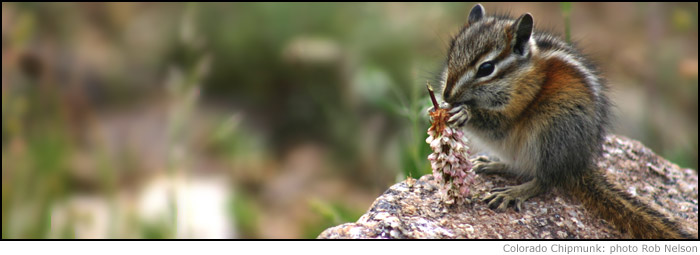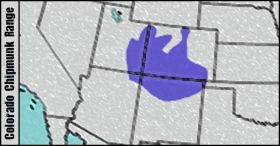The Colorado Chipmunk
Tamias quadrivittatus
A Small Stripped Squirrel
The Colorado Chipmunk (Tamias quadrivittatus) is a rodent in the squirrel family. Even though most would never mistake it for a squirrel, close observation of its behaviors and running pattern will reveal the similarity.
Description
Colorado chipmunks are medium to large chipmunks. The central dorsal stripe is black and very distinct, and the dark lateral stripes are more reddish brown. White lateral stripes are also usually well defined. In animals with recently molted pelage, the dorsal background color is bright reddish brown paling to orange-buff on the sides. The ventral color is pale gray. Measurements are: total length 200-245 mm; length of tail 90-110 mm; length of hindfoot 31-37 mm; length of ear 20-23 mm; weight 45-90 g.
Common Species: Uinta Chipmunk
A quick search for chipmunks in the west reveals a large number of fairly similar looking species in the genus Tamias. The species most easily mistaken for the Colorado chipmunk is the Uinta chipmunk. Even more difficulty identifying them is that both species can overlap in their home range. The best way to distinguish them is to look at the stripes on the back. Colorado chipmunks have dark stripes that are mostly black while the Uinta chipmunk has stripes that are brownish. Another thing to note is to look for a small dark stripe under the lowest pale stripe – only present in Colorado chipmunks. Finally, if there are distinctive white dots on the ears, you may have a Uinta chipmunk.
One final thing to pay attention to is where in Colorado you are. Uinta chipmunks overlap the range of Colorado chipmunks slightly. In the areas that they overlap, Colorado chipmunks remain in lower elevations, up to about 7,000 feet, while the Uinta chipmunk stays in higher elevations, up to about 12,000 feet.
Colorado Chipmunk Range
The Colorado chipmunk occurs in southern Colorado, where it reaches elevations of 10,500 feet. Its northern and eastern limits are in the Front Range, where it is restricted to the foothills. Along the Front Range, the Colorado chipmunk seems to occur mostly below the 7,000 foot contour.
Habitat
In the foothills and canyons, they occupy rocky, broken terrain in open woodlands and shrublands. They occur in pinyon-juniper woodlands in low elevations and montane forests in higher elevations.
Behavior
Colorado chipmunks are solitary rodents that only get together in the spring during breeding season. The rest of the time they forage for food and form small territories. Foraging is done predominately in the early morning and late afternoon.
The chipmunk call
Colorado chipmunks make small vocalizations as it sways its tail from side to side (unlike the least chipmunk which vocalizes while flicking its tail up and down).
What do these Chipmunks eat?
Chipmunks feed on a variety of food, including seeds and nuts left out in bird feeders. In the wild they feed on seeds, berries, flowers, and other plant material. In lower elevations they feed on juniper “berries” and prickly-pear. They also eat mountain mahogany, currants, wild cherry, and snowberry. It is likely that they’ll eat insects and carrion if available.
Reproduction
Colorado chipmunks in low elevations can have have two separate litters. In the spring, males and females emerge from burrows to mate. Males emerge first followed by the females which are only receptive a few days. After about a month, a female will give birth to 5 to 8 naked baby chipmunks. In 25 days, they will emerge from their dens ¾ the size of an adult. In 40 to 50 days they are weaned from their mothers.
Related Topics
A Small Stripped Squirrel
The Colorado Chipmunk (Tamias quadrivittatus) is a rodent in the squirrel family. Even though most would never mistake it for a squirrel, close observation of its behaviors and running pattern will reveal the similarity.
Description
Colorado chipmunks are medium to large chipmunks. The central dorsal stripe is black and very distinct, and the dark lateral stripes are more reddish brown. White lateral stripes are also usually well defined. In animals with recently molted pelage, the dorsal background color is bright reddish brown paling to orange-buff on the sides. The ventral color is pale gray. Measurements are: total length 200-245 mm; length of tail 90-110 mm; length of hindfoot 31-37 mm; length of ear 20-23 mm; weight 45-90 g.
Common Species: Uinta Chipmunk
A quick search for chipmunks in the west reveals a large number of fairly similar looking species in the genus Tamias. The species most easily mistaken for the Colorado chipmunk is the Uinta chipmunk. Even more difficulty identifying them is that both species can overlap in their home range. The best way to distinguish them is to look at the stripes on the back. Colorado chipmunks have dark stripes that are mostly black while the Uinta chipmunk has stripes that are brownish. Another thing to note is to look for a small dark stripe under the lowest pale stripe – only present in Colorado chipmunks. Finally, if there are distinctive white dots on the ears, you may have a Uinta chipmunk.
One final thing to pay attention to is where in Colorado you are. Uinta chipmunks overlap the range of Colorado chipmunks slightly. In the areas that they overlap, Colorado chipmunks remain in lower elevations, up to about 7,000 feet, while the Uinta chipmunk stays in higher elevations, up to about 12,000 feet.
Colorado Chipmunk Range
The Colorado chipmunk occurs in southern Colorado, where it reaches elevations of 10,500 feet. Its northern and eastern limits are in the Front Range, where it is restricted to the foothills. Along the Front Range, the Colorado chipmunk seems to occur mostly below the 7,000 foot contour.
Habitat
In the foothills and canyons, they occupy rocky, broken terrain in open woodlands and shrublands. They occur in pinyon-juniper woodlands in low elevations and montane forests in higher elevations.
Behavior
Colorado chipmunks are solitary rodents that only get together in the spring during breeding season. The rest of the time they forage for food and form small territories. Foraging is done predominately in the early morning and late afternoon.
The chipmunk call
Colorado chipmunks make small vocalizations as it sways its tail from side to side (unlike the least chipmunk which vocalizes while flicking its tail up and down).
What do these Chipmunks eat?
Chipmunks feed on a variety of food, including seeds and nuts left out in bird feeders. In the wild they feed on seeds, berries, flowers, and other plant material. In lower elevations they feed on juniper “berries” and prickly-pear. They also eat mountain mahogany, currants, wild cherry, and snowberry. It is likely that they’ll eat insects and carrion if available.
Reproduction
Colorado chipmunks in low elevations can have have two separate litters. In the spring, males and females emerge from burrows to mate. Males emerge first followed by the females which are only receptive a few days. After about a month, a female will give birth to 5 to 8 naked baby chipmunks. In 25 days, they will emerge from their dens ¾ the size of an adult. In 40 to 50 days they are weaned from their mothers.


































































































